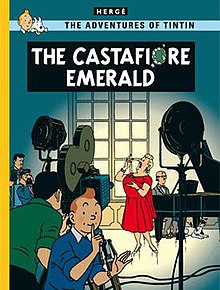
Back As choyas d'a Castafiore AN পান্না কোথায় Bengali/Bangla Les joies de la Castafiore Catalan Šperky madam Castafiore Czech Perdlysau Castafiore Welsh Castafiores juveler Danish Die Juwelen der Sängerin German Las joyas de la Castafiore Spanish جواهرات کاستافیوره Persian Castafioren korut Finnish
| The Castafiore Emerald (Les Bijoux de la Castafiore) | |
|---|---|
 Cover of the English edition | |
| Date | 1963 |
| Series | The Adventures of Tintin |
| Publisher | Casterman |
| Creative team | |
| Creator | Hergé |
| Original publication | |
| Published in | Tintin magazine |
| Issues | 665–726 |
| Date of publication | 4 July 1961 – 4 September 1962 |
| Language | French |
| Translation | |
| Publisher | Methuen |
| Date | 1963 |
| Translator |
|
| Chronology | |
| Preceded by | Tintin in Tibet (1960) |
| Followed by | Flight 714 to Sydney (1968) |
The Castafiore Emerald (French: Les Bijoux de la Castafiore) is the twenty-first volume of The Adventures of Tintin, the comics series by Belgian cartoonist Hergé. It was serialised weekly from July 1961 to September 1962 in Tintin magazine. In contrast to the previous Tintin books, Hergé deliberately broke the adventure formula he had created: it is the only book in the series where the characters remain at Marlinspike Hall, Captain Haddock's family estate, and neither travel abroad nor confront dangerous criminals. The plot concerns the visit of the opera singer Bianca Castafiore and the subsequent theft of her emerald.
Although The Castafiore Emerald received critical acclaim for its humorous depiction of its characters following a trail of red herrings, it failed to match the commercial success of previous volumes due to the experimental nature of its narrative. It was published as a book by Casterman shortly after its conclusion. Hergé continued The Adventures of Tintin with Flight 714 to Sydney, while the series itself became a defining part of the Franco-Belgian comics tradition. The story was adapted for both the 1991 Ellipse/Nelvana animated series The Adventures of Tintin and the 1992–93 BBC Radio 5 dramatisation of the Adventures.